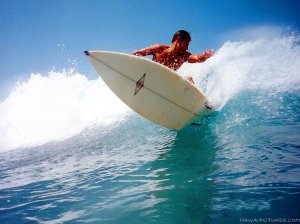Surfing the unconscious

For the first time a couple of days ago I tried to surf. I mean surfing on waves (in Hawaiian he’e nalu, “gliding on water”), what you see in many American movies from 50 years onwards, with the Beach Boys as the soundtrack and Baywatch’s towers in the distance.
I took some lessons and I found myself very capable, with great personal satisfaction. For this discipline are necessary strength in upper limbs (you row a lot to catch the wave at the right time) and of course balance.
The technique involves several steps to surf a wave. We must reach an area where you stand for “get” the wave (line up). It coincides with the point at which a wave begins to break, making a steep surfable wall. In order to begin to ride the wave the surfer swim with their bellies lying on the table, perpendicular to the wave towards the beach and when the board starts to slide independently the surfer stands up by pressing the table with both hands and pulling with a single movement (take off).
In the case of particularly large wave that is the most dangerous moment, and if dropped the surfer can incur serious consequences, especially in the presence of rocky or coral bottoms. The instructor who followed me warned me about the disruptive force of the wave and its dangers. In the event of a fall in the belly of the wave she told me to let go and not fight with the wave and curl up in fetal position, protecting the head. The wave is stronger than any swimmer, and the falling water strikes you with a chaotic incontestable force. But the wave will pass, ending its effect and in that time you can re-emerge. Even paddling into the wave, when you went to place the new line-up requires care. The maneuvers to overcome the power of waves are two: Duck Dive going under the waves by dipping the tip of the board (only with short boards); Turtle roll is made grabbing the board on side, turning upside down 180 degrees and let the wave pass.
This long digression on techniques is to highlight that it is highly inadvisable to contend with such a powerful event. But if you take off and you can begin to ride the wave then you can be transported, make flips, surf away from breaks.
After this first experience I began to think about waves in terms of unconscious. Maybe its because of the aquatic metaphor, the power and uncontrollability, the dynamics of wave generation so tied to the sea movements in general, cyclical but unpredictable, governed by complex patterns and outside of human control: a wave, think of a tsunami, you certainly can not divert, control, manipulate. A wave breaks and modifies landscapes over time, erodes the coastline, dig her groove. Then switch back and retires leaving a calm sea. But since James Cook discovered the Hawaiian natives and saw them surfing on primitive wooden tables, humans love to confront these powerful natural phenomena, having fun and trying immense joy to slip on the water. When I managed to ride the first wave I felt a euphoric sense of control and I fell in love with surfing.
But if the metaphor holds I wonder which is the surfboard that allows us to ride without having to undergo the unconscious, which techniques allow us to get up at the right time and remain on the wall, in a precarious state of balance, but without being overwhelmed by the turmoil that follows us. What can keep us directed to a safe place and which the moves? I always thought that the unconscious is a phenomenon to be exploited, which consists of uncontrollable energy but that can be surfed managing to remain afloat and upright, without hitting obstacles on the road.







